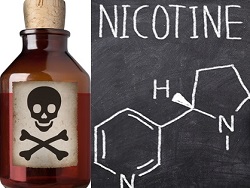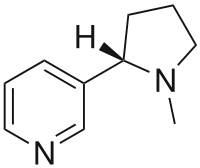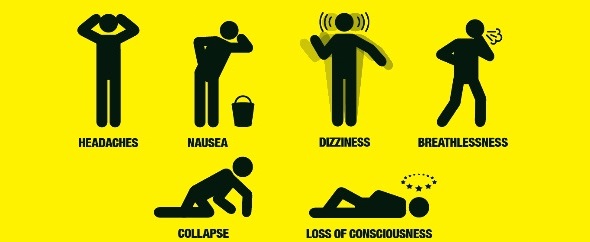 You’ll hear a lot of stuff about nicotine being more poisonous than arsenic, one of the most toxic substances known to man, and that around 30 to 60 mg is enough to kill you. These statements, however, are actually based on information contained in a speculative paragraph from 1906 and an unusual self-experimentation episode from the 19th century.
You’ll hear a lot of stuff about nicotine being more poisonous than arsenic, one of the most toxic substances known to man, and that around 30 to 60 mg is enough to kill you. These statements, however, are actually based on information contained in a speculative paragraph from 1906 and an unusual self-experimentation episode from the 19th century.
While this may be enough to allay some of your fears about the potential for fatal overdose, nicotine is still a toxic substance, and vapers should stay on the lookout for the signs of nicotine poisoning.
Key Points
- The current estimate for the toxicity of nicotine is likely to be between 10 and 20 times too low, so overdose is improbable through vaping.
- You can still consume too much, though, so it’s important to learn the symptoms of nicotine poisoning: dizziness, nausea and vomiting, increased salivation, abdominal pains, rapid heartbeat and difficulty breathing.
- If you’re vaping and experience initial symptoms, put your e-cig down for a while. If you come into contact with high-strength nicotine base or large amounts of e-liquid, seek medical care immediately.

I am not sure how genuine this concern may be for the average vaper. In general, smokers (and by inference, vapers) titrate their nicotine intake based on the feedback they get from their bodies. Feeling dizzy or nauseated is a sign of too much nicotine. Feeling fatigued, dopey, and confused is a sign of not enough nicotine. As a result, nicotine consumers self-regulate nicotine intake to meet their needs. With the exception of those affected by active psychiatric conditions, it is uncommon for the average vaper to experience symptoms of severe overdosing (e.g. progression from agitation, nausea, vomiting, tachypnea, and tremors to loss of consciousness). In order to minimize nicotine overdose in first time vapers, common sense would suggest gradual nicotine up-dosing, starting with a low/medium concentration (depending on the nicotine level in their own brand) in the e-liquid. – Professor Riccardo Polosa
How Toxic is Nicotine?
 Bernd Mayer, the man who uncovered the source of our current nicotine toxicity data, describes a chain of circular referencing and unsupported allegations surrounding the current 30 to 60 mg “fatal” dose. This works out to around 0.8 mg per kg, which is considerably less per kg than it takes to kill dogs (9.2 mg/kg), mice (3.3 mg/kg) and rats (50 mg/kg). This could be because humans are monumentally intolerant to nicotine, but evidence from people who’ve consumed much more than 60 mg and survived – as well as from the concentrations measured in the blood of people who did overdose from nicotine – indicates that it’s actually much higher. Mayer estimates that anything from 0.5 g to 1 g (ten to twenty times more than the current estimate) or more would be needed to kill an adult, putting the toxicity of nicotine at 6.5 to 13 mg/kg.
Bernd Mayer, the man who uncovered the source of our current nicotine toxicity data, describes a chain of circular referencing and unsupported allegations surrounding the current 30 to 60 mg “fatal” dose. This works out to around 0.8 mg per kg, which is considerably less per kg than it takes to kill dogs (9.2 mg/kg), mice (3.3 mg/kg) and rats (50 mg/kg). This could be because humans are monumentally intolerant to nicotine, but evidence from people who’ve consumed much more than 60 mg and survived – as well as from the concentrations measured in the blood of people who did overdose from nicotine – indicates that it’s actually much higher. Mayer estimates that anything from 0.5 g to 1 g (ten to twenty times more than the current estimate) or more would be needed to kill an adult, putting the toxicity of nicotine at 6.5 to 13 mg/kg.
In practice, this means that you are extremely, monumentally unlikely to have a fatal nicotine overdose from vaping. Even assuming that you absorb all of the nicotine from the liquid (which isn’t true), you’d need to consume about 27 ml of 18 mg/ml liquid to even approach the lower end of reasonable estimates for the fatal dosage. And you’d have to do it quickly. Since nicotine can be absorbed through the skin – especially if you’re a DIY mixer handling high-strength nicotine – it is worth exercising caution regarding non-vapor exposure, though. And for home-mixers, Mt. Baker Vapor even limits their DIY nicotine to 36mg/ml.
Symptoms of Nicotine Poisoning
Although you’re not vaping the toxicological equivalent of arsenic, you can still suffer from nicotine poisoning if you hit your e-liquid too hard or get some on your skin, so it’s important to know which symptoms to look out for.
The first symptoms of nicotine poisoning you may notice are dizziness and nausea, with others such as increased salivation and stomach pains following. Other symptoms include a burning sensation in the mouth, difficulty breathing (or rapid breathing), headaches, confusion, weakness, increased heart-rate, and in the most serious cases, tremors, convulsions and coma.

Since you’ll be consuming nicotine gradually in most cases, learning to recognize the first symptoms can help you determine when you should stop vaping for a little while.
Light dizziness happens from time to time, but it’s the first indication that you’re overdoing it a bit and should take a break.
If you start to feel nauseous, salivate more and have stomach pains, you should definitely stop vaping until you’ve recovered. Your e-liquid isn’t going anywhere, so there’s no need to rush through it.
If the situation is severe (if you’ve spilled a strong base on your skin, swallowed a significant amount of juice, e.t.c.), you should seek medical attention and wash any affected areas on your body with soap and water as soon as possible. You’re likely to be dizzy, so you shouldn’t drive. If nobody is there to take you to hospital, try to get a neighbor to take you, or alternatively call 911 or a poison control center. However, if it’s just a couple of mild symptoms from vaping they are likely to pass with time; so there’s not much to worry about unless you’ve been exposed to a lot of juice.
Conclusion
The quantities of nicotine you’re exposed to by vaping e-cigs are unlikely to cause any problems, but it’s still a good idea to be on the lookout for early signs of nicotine poisoning. If you’re taken to hospital, you’ll have your stomach pumped and probably receive activated charcoal, but in most cases there are no long-term consequences. As always, exercise additional caution when it comes to children or pets and nicotine exposure.
The Complete Guide to E-Cig Safety
Part One: Beginner E-Cigs Safety
1. Safe Use of Beginner E-Cigs
2. A Guide to Safe Charging
3. Carrying Your E-Cig Safely
4. Cartomizer Safety
5. Vaping and Driving
Part Two: E-Liquid Safety
6. Basic E-Liquid Safety
7. Allergies, Conditions and E-Liquid
8. Safe Nicotine Consumption for Vapers
9. Steeping E-Liquids Safely
10. Do E-Liquids Expire?
11. E-Liquid and Tank Safety
12. DIY E-Liquid Safety
Part Three: E-Cig Mod Safety
13. Minimizing the Risk of E-Cig Mod Explosions
14. E-Cig Mod Battery Safety and Ohm’s Law
15. Rebuildable Atomizer Safety
16. Mechanical Mod Safety
17. Wick Safety
18. Drip Tip Safety

